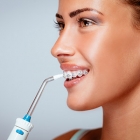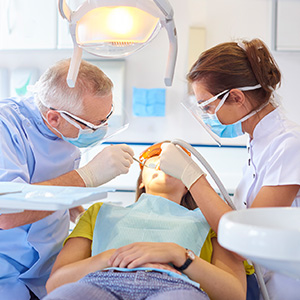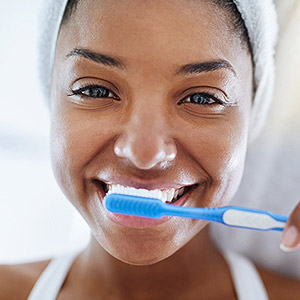Posts for tag: oral hygiene

If we were playing word association with the term “oral hygiene,” you'd probably answer “brushing.” And you would be right—brushing cleans tooth surfaces of accumulated bacterial plaque, a thin biofilm most responsible for dental disease.
But brushing is only half of the oral hygiene equation: You also need to remove dental plaque between teeth where brushing can't reach. And, that requires that other practice—flossing.
Unfortunately, brushing is more popular than its hygienic sibling because many people find traditional thread flossing more difficult and messier than brushing. That can make it tempting to skip flossing—but then you're only getting half the benefit of oral hygiene for reducing the risk of tooth decay or gum disease.
There is, however, a way to floss that doesn't involve a roll of thread: oral irrigation. This form of flossing uses a countertop device that directs a pressurized spray of water between teeth through a handheld wand. The directed spray loosens and then flushes away accumulated plaque.
Oral irrigators (also known as water flossers) have been an important tool for decades in dental offices, and have been available for home use since the 1960s. In the last few years, though, the devices have become more compact and easier to use. More importantly, studies have shown they're as effective in removing between-teeth plaque as regular flossing.
These irrigation devices are especially useful for people wearing braces. The attached brackets and wires make it extremely difficult to maneuver flossing thread between teeth. Because of this (as well as similar difficulties in brushing), patients are more susceptible to dental disease while undergoing orthodontic treatment.
But a 2008 study showed that oral irrigators are quite effective for braces wearers in removing between-teeth plaque. It found those who used an irrigator after brushing removed five times the amount of plaque than those that only brushed.
Even if you're not wearing braces, you may still find an oral irrigator to be a useful flossing alternative. Speak with your dentist for recommendations on what to look for in an oral irrigator and tips on how to use it. It could make a positive difference in your dental health.
If you would like more information on how best to keep your teeth and gums clean, please contact us or schedule an appointment for a consultation. You can also learn more about this topic by reading the Dear Doctor magazine article “Cleaning Between Your Teeth.”

After years battling disease, your troubled tooth reached its useful life's end. It's been extracted, and we've replaced it with a life-like dental implant. So now, as far as the implant goes, disease is no longer an issue…right?
Sorry, no—though not to the same degree as a natural tooth, an implant could be endangered by gum disease. Although the implant's materials can't be infected, the supporting gums and bone can.
In fact, there's a particular type of gum disease associated with implants known as peri-implantitis (“peri” around an implant; “itis” inflammation) that first affects the gums surrounding an implant. Although peri-implantitis can arise from an excess of dental cement used to affix the crown to the implant, it most commonly starts like other forms of gum disease with dental plaque.
Dental plaque, and its hardened form calculus (tartar), is a thin, bacterial biofilm that builds up on teeth surfaces. It can quickly accumulate if you don't remove it every day with proper brushing and flossing. The bacteria living in plaque can infect the outer gum tissues and trigger inflammation.
Gum disease around natural teeth can spread quickly, but even more so with implants. That's because the natural attachment of the gums helps supply antibodies that impede infection. Implants, relying solely on their connection with the bone, don't have those gum attachments. As a result, peri-implantitis can move rapidly into the supporting bone, weakening the implant to the point of failure.
The good news, though, is that peri-implantitis can be treated successfully through aggressive plaque removal and antibiotics. But the key to success is to catch it early before it progresses too far—which is why you should see your dentist at the first sign of gum swelling, redness or bleeding.
You can also prevent peri-implantitis by practicing daily brushing and flossing, including around your dental implant. You should also see your dentist twice a year (or more, if they advise) for cleanings and checkups.
Dental implants overall have a greater than 95% success rate, better than any other tooth restoration system. But they still need daily care and regular cleanings to ensure your implants are on the positive side of those statistics.
If you would like more information on caring for your dental implants, please contact us or schedule an appointment for a consultation.

"The Dog Days of summer" once referred to the rise of Sirius (the "Dog Star") with the morning sun during the month of August. Today, however, the term has more of a meteorological than astronomical meaning: It's the muggy point of summer best suited for sipping a cold beverage and doing as little as possible by the pool. A little lethargy can be forgiven during these humid days, but don't let it keep you from the daily necessities—like cleaning your teeth.
Brushing and flossing might seem an unwelcome interruption to your “dog day” pursuits (or lack thereof), but they're still necessary regardless of the season. Together, these twin tasks remove dental plaque, a bacterial buildup of food particles and the primary cause of tooth decay and gum disease.
Daily oral hygiene is one of the most important ways you can ensure your present and future dental health. It also reduces stain buildup to keep your teeth looking their shiny best and helps freshen your breath.
If that's not enough to overcome your summer doldrums, here are a few more reasons why performing these two vital teeth-cleaning tasks is less toilsome than you think.
Just 5 minutes a day. Brushing and flossing take only a fraction of your time each day. You can perform either task thoroughly in two to three minutes. Before you know it, you'll be back poolside.
No “elbow grease” required. Oral hygiene doesn't require a lot of physical exertion, especially brushing. In fact, aggressive brushing could damage your gums. All you really need is a gentle, circular motion, and the mild abrasives in your toothpaste will do the rest.
Flossing help is available. A lot of people find flossing difficult compared to brushing and may skip it altogether. But flossing is necessary to remove plaque between teeth that brushing can't reach. Usually, it's a matter of getting over the initial awkwardness of maneuvering the floss. The major mistake is that people tend to tighten their cheek muscles when trying to get their hands in their mouth. Relax your facial muscles and you can easily get the floss positioned in the mouth for proper technique. But if you don't have the manual dexterity to hold floss between your fingers, you can try pre-loaded floss threaders or a water flosser.
Relax—we have your back. Achieving the lofty goal of great dental health isn't all on your shoulders—we support your personal efforts through regular dental visits. Every six months, we remove hard-to-reach plaque and tartar (hardened plaque) and check for any emerging problems to keep your dental health on track.
A small investment of time and effort each day can help keep your mouth healthy and avoid costly dental treatment down the road. Don't worry: The pool will still be there waiting, so go brush and floss those teeth!
If you would like more information about daily dental care, please contact us or schedule a consultation. To learn more, read the Dear Doctor magazine article “Daily Oral Hygiene.”

Millions of people wear some form of removable oral appliance. The range is pretty extensive, from orthodontic clear aligners and retainers to full or partial dentures. But while they may vary in purpose, they all require the same thing: regular cleaning and maintenance.
And there's a right way to care for them, and a wrong way. The right way ensures you'll get the most out of your appliance—the wrong way might drastically curtail their longevity. Here, then, are 4 things you should and shouldn't do to keep your appliance in tip top condition.
Clean it properly. Only use cleaning agents appropriate for an oral appliance's materials. That means avoiding the use of toothpaste—the abrasives in it won't harm tooth enamel, but they can scratch some appliance materials. Instead, use dish detergent, hand soap or a recommended cleaner with a little warm water. Also, use a different brush than your regular toothbrush.
Avoid hot water and bleach. Hot or boiling water and bleach kill bacteria, but they will also damage your appliance. Hot water can warp an appliance's soft plastic and alter its fit. Bleach can blanch plastic meant to mimic gum tissue, making them less attractive; even worse, it can break down appliance materials and make them less durable.
Protect your appliance. When you take out your appliance, be sure to store it high out of reach of curious pets or young children. And while cleaning dentures in particular, place a small towel in the sink—if they slip accidentally from your hand, there's less chance of damage if they fall on a soft towel rather than a hard sink basin.
Don't wear dentures 24/7. Dentures can accumulate bacterial plaque just like your teeth. This can increase your risk of an oral infection, as well as create unpleasant mouth odors. To minimize this, take your dentures out at night while you sleep. And be sure you're cleaning them daily by hand, soaking them in an appropriate solution or with an ultrasonic cleaner.
Your oral appliance helps keep your dental health and function going. Help your appliance continue to do that for the long haul by taking proper care of it.
If you would like more information on how best to maintain your oral appliance, please contact us or schedule an appointment for a consultation. You can also learn more about this topic by reading the Dear Doctor magazine article “10 Tips for Cleaning Your Oral Appliance.”

Henry Ford famously said a customer could have any color they wanted on their Model T “as long as it was black.” Those days are over—today’s cars and trucks come with a slew of options, and not just their paint color.
There’s something else with a wide array of possible options: your choice of toothbrush. Your local store’s dental care aisle has dozens of toothbrushes in a myriad of sizes, shapes and features. And many promise better hygiene outcomes because of their unique design.
It’s enough to make your head spin. But you can narrow your search for the right toothbrush— just look for these basic qualities.
Bristle texture. At this all-important juncture between brush and teeth, softer-textured bristles are better. That might sound counter-intuitive, but soft bristles are just as capable at removing bacterial plaque, that sticky tooth film most responsible for dental disease, as stiffer bristles. Stiffer bristles, on the other hand, can damage gums and cause recession. Also, look too for rounded bristles (gentler on the gums), and multi-leveled or angled ones for better access around teeth.
Size and shape. Toothbrushes come in different sizes because, well, so do mouths. Look, then, for a brush and bristle head that can comfortably reach all the teeth in your mouth. If you have problems with manual dexterity, choose a brush with larger grip handles. A brush that’s comfortable to use and easy to handle can make your brushing more effective.
ADA Seal of Acceptance. The American Dental Association tests hygiene products like toothbrushes. If they pass the association’s standards, the manufacturer includes the ADA Seal of Approval on their packaging. Not all submit their brushes for this evaluation, so the seal’s absence doesn’t necessarily mean a brush is of low quality. The seal, though, does tell you the product passes muster with dental professionals.
It often takes a little trial and error to find the right brush, but since you should change yours out every six months, it’s a small price to experiment. And, no matter how great the brush, it’s only as good at removing plaque as the hand that holds it. So, be sure you learn proper brushing techniques—that and the right brush will keep your teeth and gums healthy.
If you would like more information on choosing the right toothbrush, please contact us or schedule an appointment for a consultation. You can also learn more about this topic by reading the Dear Doctor magazine article “Sizing Up Toothbrushes.”
